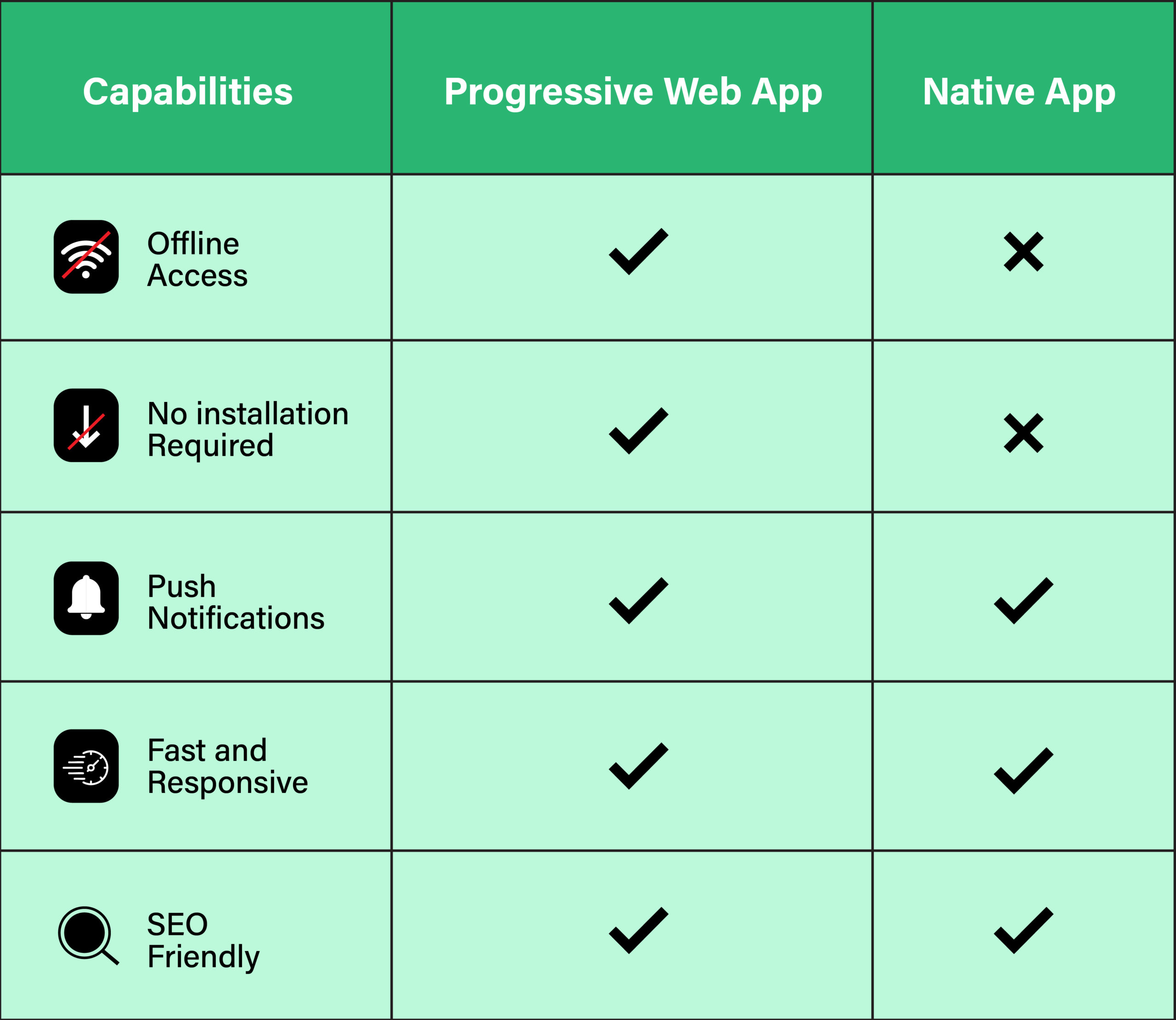Progressive Web Applications (PWAs): A Game-Changer in the Digital World
What Are Progressive Web Applications (PWAs)?
Progressive Web Applications (PWAs) are an innovative blend of web and mobile app technologies, designed to deliver a fast, engaging, and reliable user experience. Unlike native apps, PWAs are accessed through web browsers but offer app-like functionalities such as offline access, push notifications, and the ability to be installed on a device.
This technology bridges the gap between a traditional website and a mobile app, making it a cost-effective solution for businesses looking to expand their digital reach without the complexities of app store distribution.
Core Features of PWAs
- Offline Access in PWAs: Opportunities and Limitations
PWAs use service workers to cache content, enabling offline access to certain features like viewing or editing preloaded files. However, apps like Google Drive limit actions such as file uploads or real-time syncing, which require an internet connection. - Installability Without App Stores
Users can install PWAs directly from their browsers, creating a shortcut on their home screens. No app store required! - Push Notifications
PWAs enable real-time communication with users through push notifications, similar to native apps. - Fast and Responsive
PWAs are optimized for speed and work seamlessly across various devices and screen sizes. - SEO-Friendly
Unlike native apps, PWAs are indexed by search engines, enhancing discoverability.
Comparing PWAs and Native Apps
Here’s a quick look at how PWAs stack up against native apps:

Progressive Web App vs Native App
This table highlights the unique strengths of PWAs, combining the best features of both progressive web app and native apps.
Native Apps vs. Progressive Web Applications
To understand the difference more clearly, let’s compare them using specific examples:
- Spotify (Native App)
Spotify’s native app provides a seamless music streaming experience, but it requires a download from the app store and significant device storage.
Spotify PWA
Spotify also offers a PWA that allows users to stream music directly from their browser, providing a similar experience with less storage and no installation delay. - Pinterest (PWA Example)
Pinterest embraced PWAs to improve its mobile web experience. After the transition, the platform saw a 60% increase in user engagement, a significant decrease in loading time, and better overall user retention. - Google Drive (PWA Example)
Google Drive’s PWA allows users to manage files directly from their browser, offering features like offline access to recently viewed or edited documents. This makes it a convenient solution for users who need access to files across different devices without downloading a native app.
Why Choose PWAs for Your Business?
- Cost Efficiency
PWAs are highly cost-efficient because they eliminate the need for separate native apps for Android and iOS, reducing both development and maintenance costs. Instead of maintaining multiple codebases, businesses can deploy a single app that works across all devices, simplifying updates and minimizing resource requirements, leading to significant long-term savings. - Broader Audience Reach
PWAs run on any modern browser, ensuring platform compatibility across devices. This allows businesses to reach a wider audience with a single app, eliminating the need to develop and maintain separate versions for different operating systems. - Faster Deployment and Updates
PWAs bypass app store approvals, enabling instant updates that don’t require user downloads. This ensures faster rollout of new features or fixes, keeping the app up-to-date with minimal effort.
Challenges and Limitations of PWAs
- Limited iOS Features: Although improving, PWAs on iOS still lack some functionalities, such as push notifications.
- User Education: Users may not initially understand the concept of installing a PWA, requiring businesses to educate their audiences.
Progressive Web Applications are revolutionizing the digital space by offering a hybrid solution that combines the best of both worlds: the wide reach of the web and the robust functionalities of native apps. As businesses like Pinterest, Uber, and Spotify demonstrate, adopting PWAs can significantly enhance user engagement and satisfaction.
For companies looking to stay ahead in an increasingly competitive digital market, PWAs offer an opportunity to deliver exceptional user experiences while optimizing costs and resources.

13 comments
cheapest buy androxal cheap drugs
August 16, 2025 at 4:54 pmorder androxal uk in store
discount androxal online no rx
online order enclomiphene no prescription overnight delivery
August 16, 2025 at 4:56 pmhow to buy enclomiphene cost per tablet
online order enclomiphene canada shipping
order rifaximin generic alternative
August 17, 2025 at 1:54 amordering rifaximin purchase from canada
cheap rifaximin australia suppliers
buying xifaxan canadian discount pharmacy
August 17, 2025 at 1:57 amgeneric xifaxan vancouver canada
discount xifaxan cheap pharmacy
discount staxyn uk buy over counter
August 17, 2025 at 3:24 amdiscount staxyn price in canada
order chewable staxyn
buy avodart buy in australia
August 17, 2025 at 3:24 amcheapest buy avodart generic medications
purchase avodart cheap online
free dutasteride prices
August 17, 2025 at 4:43 amonline order dutasteride lowest cost pharmacy
get dutasteride canadian sales
purchase flexeril cyclobenzaprine generic from canadian pharmacy
August 17, 2025 at 4:43 amonline order flexeril cyclobenzaprine generic in united states
ordering flexeril cyclobenzaprine usa mastercard
cheapest buy gabapentin generic is it safe
August 17, 2025 at 5:41 amhow to order gabapentin cheap pharmacy
online order gabapentin generic extended release
get fildena buy virginia
August 17, 2025 at 5:46 amhow to buy fildena uk buy over counter
buy fildena buy safely online
online order itraconazole generic brand
August 17, 2025 at 6:36 amget itraconazole generic cheapest
purchase itraconazole buy in the uk
laboratoře sleva prášky kamagra
August 17, 2025 at 6:42 amobecné kamagra online nejlepší
kamagra cena
où kamagra australie
August 17, 2025 at 7:19 amkamagra coût australie
générique kamagra en nz
Comments are closed.